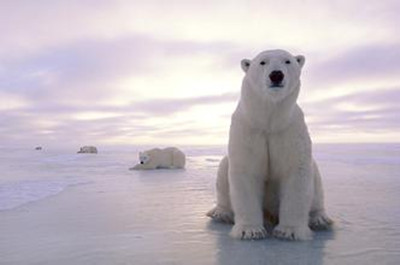A triple bacon cheeseburger seems like a heart attack on a plate.
三層奶酪咸肉漢堡感覺(jué)吃完很容易讓人突發(fā)心臟病。
So how can polar bears thrive on their version, seal blubber?
那么,北極熊是如何處理這些高熱量食物的呢?
Turns out they've stocked up on genes that let them clear fats from their blood.
結(jié)果顯示它們儲(chǔ)存在遺傳基因里的信息使得它們能夠清除血脂。
That's according to a study in the journal Cell.
這是根據(jù)《細(xì)胞》雜志上的一篇研究得出的結(jié)論。
Polar bears are well adapted to life on the sea ice.
北極熊非常適應(yīng)在浮冰上的生活。
Up to half their body weight's fat, which gives them extra insulation and buoyancy, and provides them with a ready source of energy.
幾乎占它們身重一半的脂肪足以使它們保暖并且維持體力,提供給它們一種易轉(zhuǎn)化的能量。
But how can an animal so fat also be so fit?
但一種動(dòng)物怎么能又胖又健康?

Researchers compared the genomes of polar bears with those of brown bears, and found that polar bears have accumulated genetic changes that boost their heart health and fat metabolism.
研究人員們通過(guò)比較北極熊和棕熊的基因,發(fā)現(xiàn)北極熊的基因組中積累了不少有利于心臟健康和脂肪代謝的遺傳突變。
One gene in particular, called ApoB, helps move cholesterol out of the blood—where it causes problems in humans—and into cells.
特別是編碼為載脂蛋白B的基因有助于清除血液中對(duì)人類有害的膽固醇轉(zhuǎn)變成細(xì)胞代謝。
These genomic changes happened quickly, evolutionarily speaking.
這些遺傳變化從進(jìn)化的角度來(lái)講發(fā)生的十分快。
Polar bears and brown bears diverged from a common ancestor less than half a million years ago.
北極熊和棕熊都來(lái)自于同一個(gè)祖先,它們是在大約50萬(wàn)年前左右開(kāi)始向不同分支進(jìn)化。
But if that seems super speedy, the ability to digest lactose didn't spread through human populations until we domesticated cows, just 10,000 years ago.
但是如果這種變化看上去十分快速的話,消化乳糖的酶逐漸進(jìn)化到人類各個(gè)種群中也還是發(fā)生在大概1萬(wàn)年前我們可以馴化乳牛之后。
A moooving testament to the power of natural selection.
這是自然選擇力量的證明。












